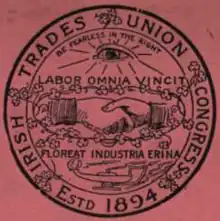Irish Trades Union Congress
The Irish Trades Union Congress (ITUC) was a union federation covering the island of Ireland.
 | |
| Merged into | Irish Congress of Trade Unions |
|---|---|
| Founded | 1894 |
| Dissolved | 1959 |
| Headquarters | Dublin, Ireland |
| Location | |
History
Until 1894, representatives of Irish trade unions attended the British Trades Union Congress (TUC). However, many felt that they had little impact on the British body, and the Dublin Trades Council had twice tried and failed to form an Irish federation of trade unions. Its third attempt, the Irish Trades Union Congress, met for the first time in April 1894.[1] Although some Irish delegates continued to attend the British TUC, their decision to bar representatives of trades councils from 1895 increased dissatisfaction, and the ITUC soon became the leading Irish union federation.[2][3] Despite this, the new federation adopted the form of the British TUC, differentiating itself primarily by offering lower subscription rates and lower costs for delegates to attend its annual congress.[1] In 1900, the British TUC asked the ITUC to amalgamate with it, but this request was rejected.[4]
In its early years, the ITUC was dominated by small craft unions. The unions of carpenters were particularly important, while the printers and tailors also proved significant. Several British-based unions with Irish members also affiliated. While initially aiming to include the "land and labour" movement, this was excluded from 1898 onwards, as its organisations were not considered to be recognised trade unions or trades councils. Early issues discussed as the congress included the campaigns for an eight-hour day, for manhood suffrage, and for improvements to pay and conditions. Calls for nationalisation were initially defeated, but were passed in 1898. While delegates votes in favour of establishing a political fund, to support favoured candidates, nothing came of this, although the ITUC did have strong links with Joseph Nannetti, who liaised on its behalf with the Irish Parliamentary Party.[1]
In 1912, the ITUC established a political arm, becoming known as the Irish Labour Party and Trade Union Congress (or Irish Trade Union Congress and Labour Party). The political wing evolved into the Labour Party. Despite the Partition of Ireland, the ITUC continued to organise throughout the island, but tensions arose between the unions based in Britain and with members in both Britain and Ireland, and the Irish-based unions. In 1936, the organisation formed a commission to examine the issue. William O'Brien put in a proposal to form ten industrial groupings with no overlaps to negotiate on behalf of workers - in effect, this would have passed existing union activities to ten industrial unions. This and three other proposals were discussed at the 1939 conference, but O'Brien and his supporters walked out and formed the Advisory Council of Irish Unions. This comprised eighteen unions based in Ireland, and accounted for about half the ITUC membership.[4]
The Advisory Council cut ties with the ITUC in 1945 and formed the Congress of Irish Unions.[4] After long negotiations, the two organisations reunited in 1959 to form the Irish Congress of Trade Unions.[5]
Affiliates
The following unions were affiliated to the ITUC as of 1925:[6]
- Amalgamated Engineering Union
- Amalgamated Society of Locomotive Engineers and Firemen
- Amalgamated Society of Slaters and Tilers
- Amalgamated Society of Tailors and Tailoresses
- Amalgamated Society of Woodcutting Machinists
- Amalgamated Society of Woodworkers
- Amalgamated Transport and General Workers' Union
- Amalgamated Union of Building Trade Workers
- Ancient Guild of Incorporated Brick and Stone Layers
- Associated Blacksmiths' and Ironworkers' Society
- Belfast and Dublin Locomotive Engine Drivers' and Firemen's Trade Union
- Civil Service Clerical Association
- Dublin Operative Plasterers' Trade Society
- Dublin Packing Case Makers
- Dublin Typographical Provident Society
- Flax Roughers' and Yarn Spinners' Trade Union
- Irish Bakers', Confectioners' and Allied Workers' Amalgamated Union
- Irish Clerical and Allied Workers' Union
- Irish Engineering Industrial Union
- Irish Garment Makers' Industrial Union
- Irish Mental Hospital Workers' Union
- Irish Municipal Employees' Trade Union
- Irish National Teachers' Organisation
- Irish National Union of Painters and Decorators
- Irish Post Office Workers' Union
- Irish Transport and General Workers' Union
- Irish Union of Distributive Workers and Clerks
- Irish Women Workers' Union
- National Amalgamated Furnishing Trades Association
- National Amalgamated Society of Operative House and Ship Painters and Decorators
- National Sailors' and Firemen's Union
- National Society of Brushmakers
- National Union of Life Assurance Workers
- National Union of Railwaymen
- National Union of Sheet Metal Workers and Gas Meter Makers of Ireland
- National Union of Vehicle Builders
- Railway Clerks' Association
- Tailors' and Garment Workers' Trade Union
- Typographical Association
- Union of Post Office Workers
- United Operative Plumbers and Domestic Engineers
By 1954, the following unions held membership:[7]
Secretaries
- 1894: John Simmons
- 1899: Hugh McManus
- 1900: E. L. Richardson
- 1910: P. T. Daly
- 1918: William O'Brien
- 1920: Thomas Johnson
- 1928: Eamonn Lynch
- 1941: Cathal O'Shannon
- 1945: Thomas Johnson
- 1945: Ruaidhri Roberts
Presidents
Treasurers
References
- O'Connor, Emmet (1992). A Labour History of Ireland. Goldenbridge: Gill and Macmillan. pp. 57–61. ISBN 0717120163.
- Trade Union: Ireland Archived 2011-04-30 at the Wayback Machine, EuroFound
- Terence Bowman, People's champion: the life of Alexander Bowman, pioneer of Labour politics, p.148
- Joan Campbell, European labor unions, p.250
- A Short History of Congress, Irish Congress of Trade Unions
- Irish Trades Union Congress, "Thirty-first Annual Report", pp.168-173
- McCarthy, Charles (1977). Trade Union in Ireland 1894–1960. Dublin: Institute of Public Administration. pp. 615–617. ISBN 0902173790.
- Donal Nevin et al., Trade Union Century, p.437
- Donal Nevin et al, Trade Union Century, p.441